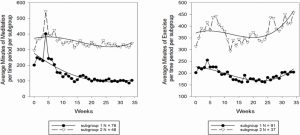Meditation and Exercise Practices can be Maintained Long-Term after Training Completion
By John M. de Castro, Ph.D.
“Maintaining your meditation practice after the course has finished is often a struggle. Without the structure of a follow-on course it’s easy to lose track, stop practising and get down-hearted and even give up.”
Over the last several decades, research and anecdotal experiences have accumulated an impressive evidential case that the development of mindfulness has positive benefits for the individual’s mental, physical, and spiritual life. Mindfulness appears to be beneficial both for healthy people and for people suffering from a myriad of illnesses. It appears to be beneficial across ages, from children to the elderly. And it appears to be beneficial across genders, personalities, race, and ethnicity. The breadth and depth of benefits is unprecedented. There is no other treatment or practice that has been shown to come anyway near the range of mindfulness’ positive benefits. With impacts so great it is important to know how to maintain mindfulness practice over the long run.
Exercise can also improve emotions and their regulation. But like mindfulness training it must be sustained over time. It is unclear, however, exactly what kind of training is essential to produce a sustainable mindfulness or exercise practice. People can differ greatly and it is also important to determine which people are most likely to sustain practice and which not.
In today’s Research News article “Predictors of Mindfulness Meditation and Exercise Practice, from MEPARI-2, a randomized controlled trial.” (See summary below or view the full text of the study at: https://www.ncbi.nlm.nih.gov/pmc/articles/PMC6959135/ ) Barrett and colleagues recruited meditation naïve, non-exercising adults who have had at least one cold per year. They were randomly assigned to either a wait-list control condition or to receive 8 weeks of training in either Mindfulness-Based Stress Reduction (MBSR) or progressive moderate intensity exercise. MBSR was taught in 8 weekly, 2.5 hour, sessions and employed discussion, breath following and body scan meditations, and yoga. progressive moderate intensity exercise was taught in weekly classes and was tailored to the individual employing a combination of walking, jogging, cycling, and exercise machines. Each program incorporated 20-45 minutes of daily practice. They were measured before and after training and every 2 months thereafter for a year for physical activity, mental and physical health, perceived stress, depression, exercise self-efficacy, mindful self-efficacy, positive and negative emotions, mindfulness, feeling loved, social support, and the big 5 personality traits of openness, conscientiousness, extraversion, agreeableness, and neuroticism. Throughout the program the participants reported their daily practice minutes.
They found that meditation in the meditation group and exercise in the exercise group was high after training and remained high over the subsequent 13 weeks. They also found that the higher the baseline measures of mental health, smoking, and the personality characteristic of openness and the lower the levels of depression, the greater the weekly average minutes of meditation practice. In addition, the higher the baseline measures of exercise, mindful self-efficacy, and overall physical activity and the lower the levels of perceived stress and neuroticism, the greater the weekly average minutes of exercise practice.
These results are remarkable and potentially important in that they demonstrated that meditation practice and exercise practice can be maintained over extended periods time after the completion of training. The authors speculate that the daily reports of practice may have contributed to the maintenance of practice. Maintenance of practice is important to maintain benefits. So, this suggests that with appropriate training and reporting, the benefits of meditation and exercise can be sustained.
It would appear that participant characteristics affected the likelihood of practice maintenance. For meditation participants who were smokers, had good mental health, had personalities characterized by openness and were low in depression were likely to maintain high levels of meditation practice while participants who at the beginning were exercisers with high self-efficacy and who were less stressed and neurotic were likely to maintain high levels of exercise practice.
So, meditation and exercise practices can be maintained long-term after training completion.
“Meditation reveals its gifts when practiced consistently and preferably daily. Our beings need to be conditioned spiritually much like fitness.” – Andrew Shykofski
CMCS – Center for Mindfulness and Contemplative Studies
This and other Contemplative Studies posts are also available on Google+ https://plus.google.com/106784388191201299496/posts and on Twitter @MindfulResearch
Study Summary
Barrett, B., Torres, E. R., Meyer, J., Barnet, J. H., & Brown, R. (2019). Predictors of Mindfulness Meditation and Exercise Practice, from MEPARI-2, a randomized controlled trial. Mindfulness, 10(9), 1842–1854. https://doi.org/10.1007/s12671-019-01137-3
Abstract
Objectives:
Health-supporting behaviors can be challenging to initiate and maintain. Data from the MEPARI-2 randomized trial were used to assess predictors of sustained exercise and meditation practice.
Methods:
Adults aged 30 to 69 years not exercising regularly and without prior meditation training were randomized to 8-week trainings in mindfulness meditation, moderate intensity exercise, or observational control, and monitored for 8 months. Exercise participants reported day-to-day minutes of moderate and vigorous activity; mindfulness meditation participants reported minutes of informal and formal practice. Demographic characteristics and psychosocial factors were assessed as predictors of practice. Growth mixture modeling was used to identify higher and lower practice subgroups.
Results:
413 participants (75.8% female; mean (SD) age 49.7 (11.6) years) were randomized to exercise (137), mindfulness meditation (138), or control (138), with 390 (95%) completing the study. Seventy-nine percent of exercisers and 62% of meditators reported ≥150 minutes/week practice for at least half of the 37 weeks monitored. Self-reported minutes of mindfulness meditation and/or exercise practice were significantly (p<0.01) predicted by baseline levels of: general mental health, self-efficacy, perceived stress, depressive symptoms, openness, neuroticism, physical activity, smoking status, and number of social contacts. Growth mixture modeling identified subsets of people with moderate (100–200 min/week) and high (300–450 min/week) levels of self-reported practice for both mindfulness meditation (62% moderate; 38% high) and exercise (71% moderate; 29% high).
Conclusions:
In this sample, participants randomized to behavioral trainings reported high levels of practice sustained over 37 weeks. Baseline psychosocial measures predicted practice levels in expected directions.
https://www.ncbi.nlm.nih.gov/pmc/articles/PMC6959135/
